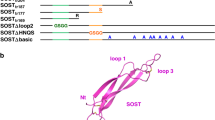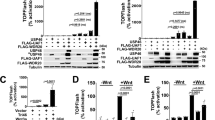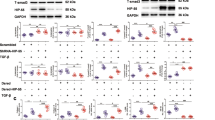Abstract
Signalling by the Wnt family of secreted lipoproteins has essential functions in development and disease1. The canonical Wnt/β-catenin pathway requires a single-span transmembrane receptor, low-density lipoprotein (LDL)-receptor-related protein 6 (LRP6)2,3,4, whose phosphorylation at multiple PPPSP motifs is induced upon stimulation by Wnt and is critical for signal transduction5. The kinase responsible for LRP6 phosphorylation has not been identified. Here we provide biochemical and genetic evidence for a ‘dual-kinase’ mechanism for LRP6 phosphorylation and activation. Glycogen synthase kinase 3 (GSK3), which is known for its inhibitory role in Wnt signalling through the promotion of β-catenin phosphorylation and degradation, mediates the phosphorylation and activation of LRP6. We show that Wnt induces sequential phosphorylation of LRP6 by GSK3 and casein kinase 1, and this dual phosphorylation promotes the engagement of LRP6 with the scaffolding protein Axin. We show further that a membrane-associated form of GSK3, in contrast with cytosolic GSK3, stimulates Wnt signalling and Xenopus axis duplication. Our results identify two key kinases mediating Wnt co-receptor activation, reveal an unexpected and intricate logic of Wnt/β-catenin signalling, and illustrate GSK3 as a genuine switch that dictates both on and off states of a pivotal regulatory pathway.
This is a preview of subscription content, access via your institution
Access options
Subscribe to this journal
Receive 51 print issues and online access
$199.00 per year
only $3.90 per issue
Buy this article
- Purchase on Springer Link
- Instant access to full article PDF
Prices may be subject to local taxes which are calculated during checkout




Similar content being viewed by others
References
Logan, C. Y. & Nusse, R. The Wnt signalling pathway in development and disease. Annu. Rev. Cell Dev. Biol. 20, 781–810 (2004)
Pinson, K. I., Brennan, J., Monkley, S., Avery, B. J. & Skarnes, W. C. An LDL-receptor-related protein mediates Wnt signalling in mice. Nature 407, 535–538 (2000)
Tamai, K. et al. LDL-receptor-related proteins in Wnt signal transduction. Nature 407, 530–535 (2000)
Wehrli, M. et al. arrow encodes an LDL-receptor-related protein essential for Wingless signalling. Nature 407, 527–530 (2000)
Tamai, K. et al. A mechanism for Wnt coreceptor activation. Mol. Cell 13, 149–156 (2004)
He, X., Semenov, M., Tamai, K. & Zeng, X. LDL receptor-related proteins 5 and 6 in Wnt/β-catenin signalling: arrows point the way. Development 131, 1663–1677 (2004)
Liu, C. et al. Control of β-catenin phosphorylation/degradation by a dual-kinase mechanism. Cell 108, 837–847 (2002)
Amit, S. et al. Axin-mediated CKI phosphorylation of β-catenin at Ser 45: a molecular switch for the Wnt pathway. Genes Dev. 16, 1066–1076 (2002)
Yanagawa, S. et al. Casein kinase I phosphorylates the Armadillo protein and induces its degradation in Drosophila. EMBO J. 21, 1733–1742 (2002)
Semenov, M. V. et al. Head inducer Dickkopf-1 is a ligand for Wnt coreceptor LRP6. Curr. Biol. 11, 951–961 (2001)
Tolwinski, N. S. et al. Wg/Wnt signal can be transmitted through arrow/LRP5,6 and Axin independently of Zw3/Gsk3β activity. Dev. Cell 4, 407–418 (2003)
Cong, F., Schweizer, L. & Varmus, H. Wnt signals across the plasma membrane to activate the beta-catenin pathway by forming oligomers containing its receptors, Frizzled and LRP. Development 131, 5103–5115 (2004)
Brennan, K., Gonzalez-Sancho, J. M., Castelo-Soccio, L. A., Howe, L. R. & Brown, A. M. Truncated mutants of the putative Wnt receptor LRP6/Arrow can stabilize β-catenin independently of Frizzled proteins. Oncogene 23, 4873–4884 (2004)
Mao, J. et al. Low-density lipoprotein receptor-related protein-5 binds to Axin and regulates the canonical Wnt signalling pathway. Mol. Cell 7, 801–809 (2001)
Obenauer, J. C., Cantley, L. C. & Yaffe, M. B. Scansite 2.0: Proteome-wide prediction of cell signalling interactions using short sequence motifs. Nucleic Acids Res. 31, 3635–3641 (2003)
Coghlan, M. P. et al. Selective small molecule inhibitors of glycogen synthase kinase-3 modulate glycogen metabolism and gene transcription. Chem. Biol. 7, 793–803 (2000)
Doble, B. W. & Woodgett, J. R. GSK-3: tricks of the trade for a multi-tasking kinase. J. Cell Sci. 116, 1175–1186 (2003)
Frame, S., Cohen, P. & Biondi, R. M. A common phosphate binding site explains the unique substrate specificity of GSK3 and its inactivation by phosphorylation. Mol. Cell 7, 1321–1327 (2001)
Dajani, R. et al. Crystal structure of glycogen synthase kinase 3 beta: structural basis for phosphate-primed substrate specificity and autoinhibition. Cell 105, 721–732 (2001)
ter Haar, E. et al. Structure of GSK3β reveals a primed phosphorylation mechanism. Nature Struct. Biol. 8, 593–596 (2001)
Hagen, T., Di Daniel, E., Culbert, A. A. & Reith, A. D. Expression and characterization of GSK-3 mutants and their effect on β-catenin phosphorylation in intact cells. J. Biol. Chem. 277, 23330–23335 (2002)
Marin, O. et al. A noncanonical sequence phosphorylated by casein kinase 1 in β-catenin may play a role in casein kinase 1 targeting of important signalling proteins. Proc. Natl Acad. Sci. USA 100, 10193–10200 (2003)
Peters, J. M., McKay, R. M., McKay, J. P. & Graff, J. M. Casein kinase I transduces Wnt signals. Nature 401, 345–350 (1999)
Sakanaka, C., Leong, P., Xu, L., Harrison, S. D. & Williams, L. T. Casein kinase Iɛ in the Wnt pathway: regulation of β-catenin function. Proc. Natl Acad. Sci. USA 96, 12548–12552 (1999)
McKay, R. M., Peters, J. M. & Graff, J. M. The casein kinase I family in Wnt signalling. Dev. Biol. 235, 388–396 (2001)
Cliffe, A., Hamada, F. & Bienz, M. A role of Dishevelled in relocating Axin to the plasma membrane during Wingless signalling. Curr. Biol. 13, 960–966 (2003)
Ruel, L., Pantesco, V., Lutz, Y., Simpson, P. & Bourouis, M. Functional significance of a family of protein kinases encoded at the shaggy locus in Drosophila. EMBO J. 12, 1657–1669 (1993)
Jia, J., Tong, C., Wang, B., Luo, L. & Jiang, J. Hedgehog signalling activity of Smoothened requires phosphorylation by protein kinase A and casein kinase I. Nature 432, 1045–1050 (2004)
Zhang, C., Williams, E. H., Guo, Y., Lum, L. & Beachy, P. A. Extensive phosphorylation of Smoothened in Hedgehog pathway activation. Proc. Natl Acad. Sci. USA 101, 17900–17907 (2004)
Apionishev, S., Katanayeva, N. M., Marks, S. A., Kalderon, D. & Tomlinson, A. Drosophila Smoothened phosphorylation sites essential for Hedgehog signal transduction. Nature Cell Biol. 7, 86–92 (2005)
Acknowledgements
We thank M. Semenov and B. MacDonald for suggestions and discussion. This work is supported in part by a grant from the NIH to X.H., who is a W. M. Keck Foundation Distinguished Young Scholar and a Leukemia and Lymphoma Society Scholar. X.Z., K.T., H.H. and R.H. are or were in part supported by postdoctoral fellowships from the Children's Hospital Boston, Uehara Memorial Foundation (Japan) and CIHR (Canada), and a training grant from the NIH, respectively. B.D. and J.W. are supported by the CIHR. J.W. is a Howard Hughes Medical Institute International Scholar. H.O. was in part supported by a grant from the NIH to Anjana Rao.
Author information
Authors and Affiliations
Corresponding author
Ethics declarations
Competing interests
Reprints and permissions information is available at npg.nature.com/reprintsandpermissions. The authors declare no competing financial interests.
Supplementary information
Supplementary Figure 1
A PPPSP kinase is associated with GST-LRP6C. (DOC 602 kb)
Supplementary Figure 2
A PPPSP kinase is associated with Axin. (DOC 218 kb)
Supplementary Figure 3
The specificity of Ab1493 for site II. (DOC 319 kb)
Supplementary Figure 4
The specificity of Ab1493 is independent of site I. (DOC 277 kb)
Supplementary Figure 5
Ck1ɛ-/- MEFs. (DOC 89 kb)
Supplementary Methods
Additional details of the methods used in this study. (DOC 25 kb)
Rights and permissions
About this article
Cite this article
Zeng, X., Tamai, K., Doble, B. et al. A dual-kinase mechanism for Wnt co-receptor phosphorylation and activation. Nature 438, 873–877 (2005). https://doi.org/10.1038/nature04185
Received:
Accepted:
Issue Date:
DOI: https://doi.org/10.1038/nature04185
This article is cited by
-
Non-canonical non-genomic morphogen signaling in anucleate platelets: a critical determinant of prothrombotic function in circulation
Cell Communication and Signaling (2024)
-
IGFBP2 drives epithelial-mesenchymal transition in hepatocellular carcinoma via activating the Wnt/β-catenin pathway
Infectious Agents and Cancer (2023)
-
Impaired neurogenesis and neural progenitor fate choice in a human stem cell model of SETBP1 disorder
Molecular Autism (2023)
-
The WNT/β-catenin system in chronic kidney disease-mineral bone disorder syndrome
International Urology and Nephrology (2023)
-
SIK2 maintains breast cancer stemness by phosphorylating LRP6 and activating Wnt/β-catenin signaling
Oncogene (2022)
Comments
By submitting a comment you agree to abide by our Terms and Community Guidelines. If you find something abusive or that does not comply with our terms or guidelines please flag it as inappropriate.



